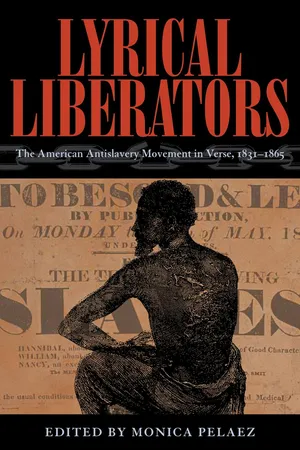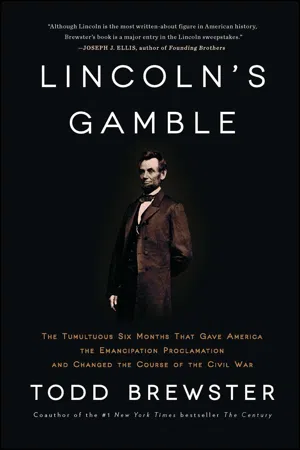History
Fugitive Slave Act
The Fugitive Slave Act was a law passed by the United States Congress in 1850 as part of the Compromise of 1850. It required that escaped slaves be returned to their owners, even if they were found in free states. This controversial law heightened tensions between the North and South and contributed to the growing abolitionist movement.
Written by Perlego with AI-assistance
Related key terms
6 Key excerpts on "Fugitive Slave Act"
- eBook - ePub
Lyrical Liberators
The American Antislavery Movement in Verse, 1831–1865
- Monica Pelaez(Author)
- 2018(Publication Date)
- Ohio University Press(Publisher)
3 FUGITIVE SLAVESNO OTHER TOPIC motivated as many poets as fugitive slaves, particularly in the aftermath of the passage of the controversial Fugitive Slave Act of September 18, 1850. Yet as early as the 1830s, poets were already illustrating the desperate conditions of slavery by addressing the circumstances that compelled up to a thousand slaves a year to flee, and the challenges they faced in the course of their escape.1 Their indignation further ramped up once Congress passed the act as part of the Compromise of 1850, which consisted of five separate bills resulting from a four-year dispute between free and slave states concerning the status of new territories acquired during the Mexican-American War. These bills included creating the New Mexico and Utah Territories without forbidding slavery within their boundaries, abolishing the public sale of slaves in the District of Columbia, and admitting the free state of California.2 The act was thus a sort of concession to slave-state politicians who objected to the imbalance created by adding another free state. It required federal law-enforcement officials in all states and territories to assist with the return of escaped slaves to their masters. Suspected fugitives could be arrested simply on the basis of a claimant’s assertion of ownership, and they had neither the ability to testify on their own behalf nor recourse to a jury trial. This meant in effect that a freedman accused of being a fugitive could not dispute the charge. In addition, the act stipulated that any citizen who harbored a runaway or interfered with his apprehension was subject to a $1,000 fine and imprisonment of up to six months. While there are diverging figures concerning how many fugitive cases were actually prosecuted—one source estimates there were 332 cases in the ten years following the act’s passage3 —the act had enormous symbolic importance for activists who portrayed it as an attempt by the South to assert control over the North. Abolitionists argued that it proved the political “slave power” in Congress had not only brought the federal government into “the business of man-hunting,” but also “required every freeborn American to become a manhunter.”4 The act also intensified fear among free blacks in the North, many of whom fled to Canada as a result. Its many objectionable implications were therefore widely relied on by activists to mobilize support for the cause, and in particular for the operations of the Underground Railroad “stations” that sprang up at geographically advantageous locations in the states of Pennsylvania, Ohio, Indiana, and Illinois. Eric Foner estimates that its “conductors” helped close to 30,000 fugitives reach freedom between 1830 and 1860.5 - eBook - ePub
The Rescue of Joshua Glover
A Fugitive Slave, the Constitution, and the Coming of the Civil War
- H. Robert Baker(Author)
- 2006(Publication Date)
- Ohio University Press(Publisher)
Prigg settle the matter. Discontent and disagreement led to congressional action and a new Fugitive Slave Act in 1850. The new law dramatically altered accepted practices and led to resistance far more ferocious than any that the 1793 law had ever occasioned.The Fugitive Slave Act’s constitutionality was more complicated than the issuance and acceptance of judicial opinions declaring it so. Its constitutionality was bound up in its history, a skein of issues stretching from compromises over slavery to the duties of states to their citizens; from the role of Congress as a mediator among sovereign states to its increasingly difficult role as balancer of the interests of free and slave states. The 1793 constitutional settlement that made the rendition of fugitive slaves both a federal and a state imperative and left the protection of free blacks to the states came under enormous pressure as slavery expanded into the trans-Appalachian southwest and as antislavery sentiments quickened in northern and border states. By the 1830s, strain on the old compromise had permanently altered its features.The constitutionality of the Fugitive Slave Act was not based on timeless principles extracted from the nation’s founding document. Instead, its constitutionality was in the process that created it, sustained it for six decades, and ultimately brought it crashing down under the weight of public opinion after 1854. In a very real way, its history was its constitutionality and, ultimately, its unconstitutionality.The Fugitive Slave Act was firmly rooted in several sources of law, but the compromises that created it did not tie these sources together in a neat way. There was the common-law right of recaption, the well-recognized right of a master or a paterfamilias to pursue dependents bound to his authority, capture them, and return them to his household. There were limits to this power. It was not to be attended with violence or to breach the peace.1 If the threat of violence existed, it was the duty of peace officers to intervene. This right of recaption had long been exercised by slaveholders in Britain’s American colonies, and most presumed that it would continue after independence. The issue came up at the 1787 constitutional convention. Early on, James Madison noted that “the great division of interests among the states was over slavery, and that this, more than anything else, would strain the bonds of union over time.”2 Time bore out Madison’s prescient observation; but in the midst of the convention, more immediate details needed hammering out. Representation and taxation topped the list, and delegates from South Carolina and Georgia made it clear that they wanted assurances that the slave trade would not be banned, at least until those states could replenish their supply of labor depleted by the Revolutionary War.3 The various compromises between free and slave states engendered controversy both inside and outside the convention, especially as the antislavery cause gained powerful spokesmen like Benjamin Franklin.4 - eBook - ePub
William Still
The Underground Railroad and the Angel at Philadelphia
- William C. Kashatus(Author)
- 2021(Publication Date)
- University of Notre Dame Press(Publisher)
FOUR The Fugitive Slave ActThe Vigilant Committee of Philadelphia ceased operations at the very time freedom seekers needed it most. To placate slaveholders who complained about the increasing number of escapes, Congress, in 1850, passed a stronger fugitive slave law than the earlier 1793 act.1 The infamous measure placed the freedom of every northern black in jeopardy. Slave catchers became ruthless in their quest. The kidnapping of free blacks increased dramatically. Some blacks armed themselves, intending to fight to the death for their freedom.“The new law strips us of all manner of protection,” editorialized the Liberator, William Lloyd Garrison’s antislavery newspaper. “It throws us back upon the natural and inalienable right of self-defense.”2 By November, fugitives who had fled to Pennsylvania as well as the free black population of the state were “arming themselves with pistols, bowie knives and rifles to prevent kidnapping.”3 Other blacks sought protection elsewhere. Within three months of the bill’s passage, an estimated three thousand fugitive slaves crossed the US border into Canada.4 “It is hardly too much to say that Pennsylvania is considered wholly unsafe to nine-tenths of her colored population,” wrote William Still. “They believe it far better to head for Canada than to remain here.”5The Fugitive Slave Act of 1850 brought political tensions between the North and the South to a boiling point. At issue was the future of the United States, specifically whether it would become a modern country with an industrial economy based on free labor or remain dependent on an agricultural economy fueled by slave labor. The conflict had been building since the beginning of the nineteenth century as the nation expanded westward. With the purchase of the Louisiana Territory from France in 1803, the federal government acquired some 828,000 square miles, almost doubling the geographical size of the country. In time, thirteen new states would be carved out of the new territory, and the admission of these states to the Union would stir bitter debates in Congress over the expansion of slavery. The first test came in 1819 when Missouri applied for statehood. - eBook - ePub
Border War
Fighting over Slavery before the Civil War
- Stanley Harrold(Author)
- 2010(Publication Date)
- The University of North Carolina Press(Publisher)
If the judge or commissioner accepted the evidence, he could issue a certificate of removal that no other legal process would override. Anyone who interfered with either the capture or return of an alleged slave faced fines and imprisonment up to six months. As the bill progressed through the U.S. Senate during the spring and summer of 1850, southerners, supported by some northern Democrats, defeated efforts to require jury trials for, or allow writs of habeas corpus on behalf of, the accused. On August 19, Mason maintained—based on “the experience of the people of those States from whence these fugitives escape”—such provisions would defeat the purpose of the new law. 12 Conflict along the North-South border fortified Border South determination to defeat northern modifications of the bill. As discussed in chapter 6, nearly simultaneous, high-profile slave escapes transpired in Maryland, the District of Columbia, and Virginia. These events left little doubt among the region’s leaders that an escape crisis required federal action. The Lexington Observer stressed the importance citizens of “the border States of Kentucky, Virginia, and Maryland” placed on employing “U.S. appointees” to aid masters. Therefore, when on September 16 Congress passed the Fugitive Slave Act of 1850, and President Fillmore signed it into law two days later, most white border southerners responded with enthusiasm. Congressman Thomas H. Bayly of Virginia claimed the new law would stop the outflow of “young and most valuable” slaves. The Missouri Republican portrayed the law as a means of helping those who had lost slaves and suffered difficulties in recaption. The only dispute concerned how much force might be necessary to achieve the desired result - eBook - ePub
Slavery and the Founders
Race and Liberty in the Age of Jefferson
- Paul Finkelman(Author)
- 2014(Publication Date)
- Routledge(Publisher)
54Because the records of Congress for this period are scant, it is impossible to reconstruct fully the debates. It is clear, however, that the fugitive slave law did not sail smoothly through Congress. The debates in the Senate were particularly bitter. The deletion of virtually all of Senate Bill 1 and many of the provisions of Senate Bills 2 and 3 indicates the divisions within the Senate. The report in the Journal of the Senate that “progress” was made on January 14 and 16 suggests that progress had been slow up to that point.The last-minute effort in the Senate to lower the penalty for those who aided fugitive slaves also suggests the sectional aspects of the debate. Some northern senators were obviously unhappy with a law that might financially destroy their ethically motivated constituents: in 1793, $500 was a substantial sum of money. This northern opposition indicates that even in the 1790s opposition to slavery had some force. The defeat of this amendment, combined with other changes in the law favorable to the South, similarly suggests that the southern senators were far more unified in debate than their northern counterparts. The southerners, although outnumbered in the Senate, were able to mold the 1793 act to protect their interests. This was similar to what southern politicians had successfully accomplished at the Constitutional Convention in 1787 and also in the first Congress.The attempt by Congressman Moore to increase the penalties for those who helped fugitive slaves escape suggests that some southerners doubted the bill would be effective in preventing northerners from aiding fugitive slaves. But the failure of his motion should not be seen as a defeat of southern interests. More likely, it indicated that most members of the House, including those from the South, did not want to prolong debate over a bill that, in one form or another, had been under consideration for over a year. A full debate of Moore’s amendment might have undermined the whole bill. Most southerners in the House must have realized that a $500 penalty was high enough, especially since the bill preserved a suit at common law for any other costs or losses associated with someone interfering with the rendition process. This included a suit for the full value of any slaves actually lost. - eBook - ePub
Lincoln's Gamble
The Tumultuous Six Months that Gave America the Emancipation Proclamation and Changed the Course of the Civil War
- Todd Brewster(Author)
- 2014(Publication Date)
- Scribner(Publisher)
Yet Lincoln’s task remained difficult. However euphemistically it might be worded, the Constitution, in its fugitive-slave clause, undeniably protected slavery, and the document’s ratification by the Southern states was well known to have depended upon its protection of slavery; to claim something otherwise was to argue against the historical record. Lincoln also faced the (very) inconvenient fact that the Founders, with one or two exceptions, were slaveholders themselves. Some of them may have been reluctant slaveholders, but they were slaveholders nonetheless. (Washington’s will called for the freeing of his slaves upon his death; Madison, while a slaveholder his entire life, was an early advocate for freeing the slaves and sending them back to Africa; and Jefferson, well, what can we say about the author of “all men are created equal” who fathered children with the slave girl Sally Hemings and upon his death had his slaves sold off to pay his commanding debts?) Finally, an equally awkward detail was that Congress had reinforced its support for slavery when it passed the Fugitive Slave Act of 1850, which, responding to the North’s unwillingness to comply with the practice of returning escaped slaves, now required Northern officials to return them under penalty of a fine. As part of the Compromise of 1850, the act had even earned the vote of Daniel Webster, the great orator and Massachusetts senator, who hoped that it would spare the country from the civil war that seemed to be the only alternative. It didn’t, and Webster’s son, Fletcher Webster, fighting for the Twelfth Massachusetts Infantry, would succumb to a bullet at the Second Battle of Bull Run.In a sense, the debate between Douglas and Lincoln was one of priority. Did the “equality-claiming,” God-centered, “natural law–avowing” Declaration take precedence over the “slavery-protecting,” secular, law-focused Constitution, or the Constitution over the Declaration? Were the two documents mutually exclusive, or could they be seen in a dependent formation, the notion of “equality” becoming a fundamental precondition for the sort of representative democracy that the Constitution, well, “constituted”? Lincoln certainly thought this, having described equality as the “sheet anchor of American republicanism” and, in another brilliant image, this one borrowed from the book of Proverbs, the Declaration as the “apple of gold” framed by the Constitution’s “picture of silver,” with the picture (think frame
Learn about this page
Index pages curate the most relevant extracts from our library of academic textbooks. They’ve been created using an in-house natural language model (NLM), each adding context and meaning to key research topics.





